Effect of Climate Change on Hydrology, Sediment and Nutrient Losses in Two Lowland Catchments in Poland
Abstract
:1. Introduction
2. Materials and Methods
2.1. Study Area
- agriculture: its intensity, reflected by the crop structure, fertilizer rates, livestock density and the level of drainage;
- population density and its derivatives, e.g., the amount of pollution from the wastewater treatment plants (WWTPs); and
- water retention (reservoirs and ponds).
2.2. Modelling Approach
2.2.1. Model Setup, Calibration and Validation
- Diffuse pollution from agricultural areas: Commune-level statistical data were used to determine mineral fertilizer use and livestock population in order to impose a spatial variability of fertilizer rates in the model setup.
- WWTPs: Defined in the model setup only when the daily average wastewater discharge exceeded 50 m3·day−1. For each WWTP, discharge and nutrient loads were expressed as constant or mean yearly values depending on the available data, usually originating from plant operators.
- The septic systems function of SWAT was used to model the effect of pollution loads coming from population not connected to WWTPs (using cesspits or septic tanks, with or without sub-surface drainage).
- Atmospheric deposition (dry and wet) of nitrogen (nitrate and ammonium): Defined based on one station for the Upper Narew and three stations for the Barycz as a fixed average value for the entire catchments.
2.2.2. Climate Change Scenarios
3. Results
3.1. Climatic Projections
3.2. Hydrological Response to Climate Change
3.2.1. Snow Melt
3.2.2. Evapotranspiration and Soil Water
3.2.3. Water Yield, Surface Runoff and Baseflow
3.3. Sediment and Nutrient Transport Response to Climate Change
4. Discussion
Acknowledgments
Author Contributions
Conflicts of Interest
References
- Pachauri, R.K.; Meyer, L.A. Climate Change 2014: Synthesis Report. Contribution of Working Groups I, II and III to the Fifth Assessment Report of the Intergovernmental Panel on Climate Change; IPCC: Geneva, Switzerland, 2014; p. 151. [Google Scholar]
- Jacob, D.; Petersen, J.; Eggert, B.; Alias, A.; Christensen, O.B.; Bouwer, L.M.; Braun, A.; Colette, A.; Déqué, M.; Georgievski, G.; et al. EURO-CORDEX: New high-resolution climate change projections for European impact research. Reg. Environ. Chang. 2014, 14, 563–578. [Google Scholar] [CrossRef]
- Alfieri, L.; Burek, P.; Feyen, L.; Forzieri, G. Global warming increases the frequency of river floods in Europe. Hydrol. Earth Syst. Sci. 2015, 19, 2247–2260. [Google Scholar] [CrossRef] [Green Version]
- Roudier, P.; Andersson, J.C.M.; Donnelly, C.; Feyen, L.; Greuell, W.; Ludwig, F. Projections of future floods and hydrological droughts in Europe under a +2 °C global warming. Clim. Chang. 2016, 135, 341–355. [Google Scholar] [CrossRef] [Green Version]
- Papadimitriou, L.V.; Koutroulis, A.G.; Grillakis, M.G.; Tsanis, I.K. High-end climate change impact on European runoff and low flows—Exploring the effects of forcing biases. Hydrol. Earth Syst. Sci. 2016, 20, 1785–1808. [Google Scholar] [CrossRef]
- Krysanova, V.; Kundzewicz, Z.W.; Piniewski, M. Assessment of climate change impact on water resoures. In Handbook of Applied Hydrology, 2nd ed.; Singh, V.P., Ed.; McGraw-Hill Education: New York, NY, USA, 2016; p. 1440. [Google Scholar]
- Teutschbein, C.; Seibert, J. Regional Climate Models for Hydrological Impact Studies at the Catchment Scale: A Review of Recent Modeling Strategies: Regional climate models for hydrological impact studies. Geogr. Compass 2010, 4, 834–860. [Google Scholar] [CrossRef] [Green Version]
- Martínková, M.; Hesse, C.; Krysanova, V.; Vetter, T.; Hanel, M. Potential impact of climate change on nitrate load from the Jizera catchment (Czech Republic). Phys. Chem. Earth Parts ABC 2011, 36, 673–683. [Google Scholar] [CrossRef]
- Meier, H.E.M.; Müller-Karulis, B.; Andersson, H.C.; Dieterich, C.; Eilola, K.; Gustafsson, B.G.; Höglund, A.; Hordoir, R.; Kuznetsov, I.; Neumann, T.; et al. Impact of Climate Change on Ecological Quality Indicators and Biogeochemical Fluxes in the Baltic Sea: A Multi-Model Ensemble Study. AMBIO 2012, 41, 558–573. [Google Scholar] [CrossRef] [PubMed]
- Piniewski, M.; Kardel, I.; Giełczewski, M.; Marcinkowski, P.; Okruszko, T. Climate Change and Agricultural Development: Adapting Polish Agriculture to Reduce Future Nutrient Loads in a Coastal Watershed. AMBIO 2014, 43, 644–660. [Google Scholar] [CrossRef] [PubMed]
- Ahmadi, M.; Records, R.; Arabi, M. Impact of climate change on diffuse pollutant fluxes at the watershed scale. Hydrol. Process. 2014, 28, 1962–1972. [Google Scholar] [CrossRef]
- Huttunen, I.; Lehtonen, H.; Huttunen, M.; Piirainen, V.; Korppoo, M.; Veijalainen, N.; Viitasalo, M.; Vehviläinen, B. Effects of climate change and agricultural adaptation on nutrient loading from Finnish catchments to the Baltic Sea. Sci. Total Environ. 2015, 529, 168–181. [Google Scholar] [CrossRef] [PubMed]
- Glavan, M.; Ceglar, A.; Pintar, M. Assessing the impacts of climate change on water quantity and quality modelling in small Slovenian Mediterranean catchment—Lesson for policy and decision makers: Assessing the impacts of climate change on river basin modelling. Hydrol. Process. 2015, 29, 3124–3144. [Google Scholar] [CrossRef]
- Mehdi, B.; Ludwig, R.; Lehner, B. Evaluating the impacts of climate change and crop land use change on streamflow, nitrates and phosphorus: A modeling study in Bavaria. J. Hydrol. Reg. Stud. 2015, 4, 60–90. [Google Scholar] [CrossRef]
- Gombault, C.; Madramootoo, C.A.; Michaud, A.; Beaudin, I.; Sottile, M.-F.; Chikhaoui, M.; Ngwa, F. Impacts of climate change on nutrient losses from the Pike River watershed of southern Québec. Can. J. Soil Sci. 2015, 95, 337–358. [Google Scholar] [CrossRef]
- Malsy, M.; Flörke, M.; Borchardt, D. What drives the water quality changes in the Selenga Basin: Climate change or socio-economic development? Reg. Environ. Chang. 2016, 16, 209–216. [Google Scholar] [CrossRef]
- Ye, L.; Grimm, N.B. Modelling potential impacts of climate change on water and nitrate export from a mid-sized, semiarid watershed in the US Southwest. Clim. Chang. 2013, 120, 419–431. [Google Scholar] [CrossRef]
- Cousino, L.K.; Becker, R.H.; Zmijewski, K.A. Modeling the effects of climate change on water, sediment, and nutrient yields from the Maumee River watershed. J. Hydrol. Reg. Stud. 2015, 4, 762–775. [Google Scholar] [CrossRef]
- Jha, M.K.; Gassman, P.W.; Panagopoulos, Y. Regional changes in nitrate loadings in the Upper Mississippi River Basin under predicted mid-century climate. Reg. Environ. Chang. 2015, 15, 449–460. [Google Scholar] [CrossRef]
- Arheimer, B.; Dahné, J.; Donnelly, C. Climate Change Impact on Riverine Nutrient Load and Land-Based Remedial Measures of the Baltic Sea Action Plan. AMBIO 2012, 41, 600–612. [Google Scholar] [CrossRef] [PubMed]
- Records, R.M.; Arabi, M.; Fassnacht, S.R.; Duffy, W.G.; Ahmadi, M.; Hegewisch, K.C. Climate change and wetland loss impacts on a western river’s water quality. Hydrol. Earth Syst. Sci. 2014, 18, 4509–4527. [Google Scholar] [CrossRef]
- Molina-Navarro, E.; Trolle, D.; Martínez-Pérez, S.; Sastre-Merlín, A.; Jeppesen, E. Hydrological and water quality impact assessment of a Mediterranean limno-reservoir under climate change and land use management scenarios. J. Hydrol. 2014, 509, 354–366. [Google Scholar] [CrossRef]
- Mehdi, B.; Lehner, B.; Gombault, C.; Michaud, A.; Beaudin, I.; Sottile, M.-F.; Blondlot, A. Simulated impacts of climate change and agricultural land use change on surface water quality with and without adaptation management strategies. Agric. Ecosyst. Environ. 2015, 213, 47–60. [Google Scholar] [CrossRef]
- Jayakody, P.; Parajuli, P.B.; Cathcart, T.P. Impacts of climate variability on water quality with best management practices in sub-tropical climate of USA. Hydrol. Process. 2014, 28, 5776–5790. [Google Scholar] [CrossRef]
- El-Khoury, A.; Seidou, O.; Lapen, D.R.; Que, Z.; Mohammadian, M.; Sunohara, M.; Bahram, D. Combined impacts of future climate and land use changes on discharge, nitrogen and phosphorus loads for a Canadian river basin. J. Environ. Manag. 2015, 151, 76–86. [Google Scholar] [CrossRef] [PubMed]
- Hesse, C.; Krysanova, V.; Stefanova, A.; Bielecka, M.; Domnin, D.A. Assessment of climate change impacts on water quantity and quality of the multi-river Vistula Lagoon catchment. Hydrol. Sci. J. 2015, 1–22. [Google Scholar] [CrossRef]
- Van der Linden, P.; Mitchell, J.F.B. ENSEMBLES: Climate Change and Its Impacts: Summary of Research and Results from the ENSEMBLES Project—European Environment Agency; Met Office Hadley Centre: Exeter, UK, 2009.
- Pazdro, Z.; Kozerski, B. Hydrogeologia Ogólna; Wyd. 4. uzup.; Wydaw. Geol: Warsaw, Poland, 1990. (In Polish) [Google Scholar]
- Piniewski, M.; Szcześniak, M.; Kardel, I.; Berezowski, T.; Okruszko, T.; Srinivasan, R.; Schulerd, V.; Kundzewicz, Z.W. Hydrological modelling of the Vistula and Odra river basins using SWAT. Hydrol. Sci. J. 2017. accepted. [Google Scholar]
- Central Statistical Office Local Data Bank—Statistics for Year 2010. Available online: http://bdl.stat.gov.pl (accessed on 20 November 2016).
- Map of Hydrological Division of Poland in the scale 1:10 000; General of National Water Management Authority: Warsaw, Poland, 2013.
- Miatkowski, Z.; Smarzyńska, K. Dynamika zmian stężenia związków azotu w wodach górnej Zgłowiączki w latach 1990–2011. Woda-Śr.-Obsz. Wiej. 2014, 3, 99–111. Available online: http://www.itep.edu.pl/wydawnictwo/woda/zeszyt_47_2014/artykuly/Miatkowski%20Smarzynska.pdf (accessed on 20 November 2016). [Google Scholar]
- Ilnicki, P.; Gorecki, K.; Lewandowski, P.; Farat, R. Long-Term Variability of Total Nitrogen and Total Phosphorus Concentration and Load in the South Part of the Baltic Sea Basin. Fresenius Environ. Bull. 2016, 25, 3923–3940. [Google Scholar]
- Banaszuk, P.; Wysocka-Czubaszek, A. Phosphorus dynamics and fluxes in a lowland river: The Narew Anastomosing River System, NE Poland. Ecol. Eng. 2005, 25, 429–441. [Google Scholar] [CrossRef]
- Marcinkowski, P.; Piniewski, M.; Kardel, I.; Srinivasan, R.; Okruszko, T. Challenges in modelling of water quantity and quality in two contrasting meso-scale catchments in Poland. J. Water Land Dev. 2016, 31, 97–111. [Google Scholar] [CrossRef]
- Neitsch, S.; Arnold, J.; Kiniry, J.; Williams, J. Soil and Water Assessment Tool Theoretical Documentation Version 2009. Technical Report TR-406; Texas A&M University: College Station, TX, USA, 2011; Available online: http://swat.tamu.edu/media/99192/swat2009-theory.pdf (accessed on 1 November 2016).
- Berezowski, T.; Szcześniak, M.; Kardel, I.; Michałowski, R.; Okruszko, T.; Mezghani, A.; Piniewski, M. CPLFD-GDPT5: High-resolution gridded daily precipitation and temperature data set for two largest Polish river basins. Earth Syst. Sci. Data 2016, 8, 127–139. [Google Scholar] [CrossRef]
- Szcześniak, M.; Piniewski, M. Improvement of Hydrological Simulations by Applying Daily Precipitation Interpolation Schemes in Meso-Scale Catchments. Water 2015, 7, 747–779. [Google Scholar] [CrossRef]
- Gupta, H.V.; Kling, H.; Yilmaz, K.K.; Martinez, G.F. Decomposition of the mean squared error and NSE performance criteria: Implications for improving hydrological modelling. J. Hydrol. 2009, 377, 80–91. [Google Scholar] [CrossRef]
- Moriasi, D.N.; Arnold, J.G.; Van, L.; Bingner, R.L.; Harmel, R.D.; Veith, T.L. Model evaluation guidelines for systematic quantification of accuracy in watershed simulations. Trans. ASABE 2007, 50, 885–900. [Google Scholar] [CrossRef]
- Piniewski, M.; Marcinkowski, P.; Kardel, I.; Giełczewski, M.; Izydorczyk, K.; Frątczak, W. Spatial Quantification of Non-Point Source Pollution in a Meso-Scale Catchment for an Assessment of Buffer Zones Efficiency. Water 2015, 7, 1889–1920. [Google Scholar] [CrossRef]
- Mezghani, A.; Dobler, A.; Haugen, J.H. CHASE-PL Climate Projections: 5-km Gridded Daily Precipitation & Temperature Dataset (CPLCP-GDPT5). Available online: http://data.4tu.nl/repository/uuid:e940ec1a-71a0-449e-bbe3-29217f2ba31d (accessed on 10 November 2016).
- Piniewski, M.; Szcześniak, M.; Mezghani, A.; Kundzewicz, Z.W. Regional projections of temperature and precipitation changes: Robustness and uncertainty aspects. Meteorol. Z. 2017. accepted. [Google Scholar]
- Gudmundsson, L.; Bremnes, J.B.; Haugen, J.E.; Engen-Skaugen, T. Technical Note: Downscaling RCM precipitation to the station scale using statistical transformations—A comparison of methods. Hydrol. Earth Syst. Sci. 2012, 16, 3383–3390. [Google Scholar] [CrossRef]
- Knutti, R.; Sedláček, J. Robustness and uncertainties in the new CMIP5 climate model projections. Nat. Clim. Chang. 2013, 3, 369–373. [Google Scholar] [CrossRef]
- Piniewski, M.; Szcześniak, M.; Huang, S.; Kundzewicz, Z.W. Projections of runoff in the Vistula and the Odra river basins with the help of the SWAT Model. Hydrol. Res. 2017. under review. [Google Scholar]
- Sun, N.; Yearsley, J.; Baptiste, M.; Cao, Q.; Lettenmaier, D.P.; Nijssen, B. A spatially distributed model for assessment of the effects of changing land use and climate on urban stream quality: Development of a Spatially Distributed Urban Water Quality Model. Hydrol. Process. 2016, 30, 4779–4798. [Google Scholar] [CrossRef]
- Kundzewicz, Z.W. Water problems of central and eastern Europe—A region in transition. Hydrol. Sci. J. 2001, 46, 883–896. [Google Scholar] [CrossRef]
- Szporak-Wasilewska, S.; Piniewski, M.; Kubrak, J.; Okruszko, T. What we can learn from a wetland water balance? Narew National Park case study. Ecohydrol. Hydrobiol. 2015, 15, 136–149. [Google Scholar] [CrossRef]
- Thorup-Kristensen, K.; Nielsen, N.E. Modelling and measuring the effect of nitrogen catch crops on the nitrogen supply for succeeding crops. Plant Soil 1998, 203, 79–89. [Google Scholar] [CrossRef]
- Laurent, F.; Ruelland, D. Assessing impacts of alternative land use and agricultural practices on nitrate pollution at the catchment scale. J. Hydrol. 2011, 409, 440–450. [Google Scholar] [CrossRef]
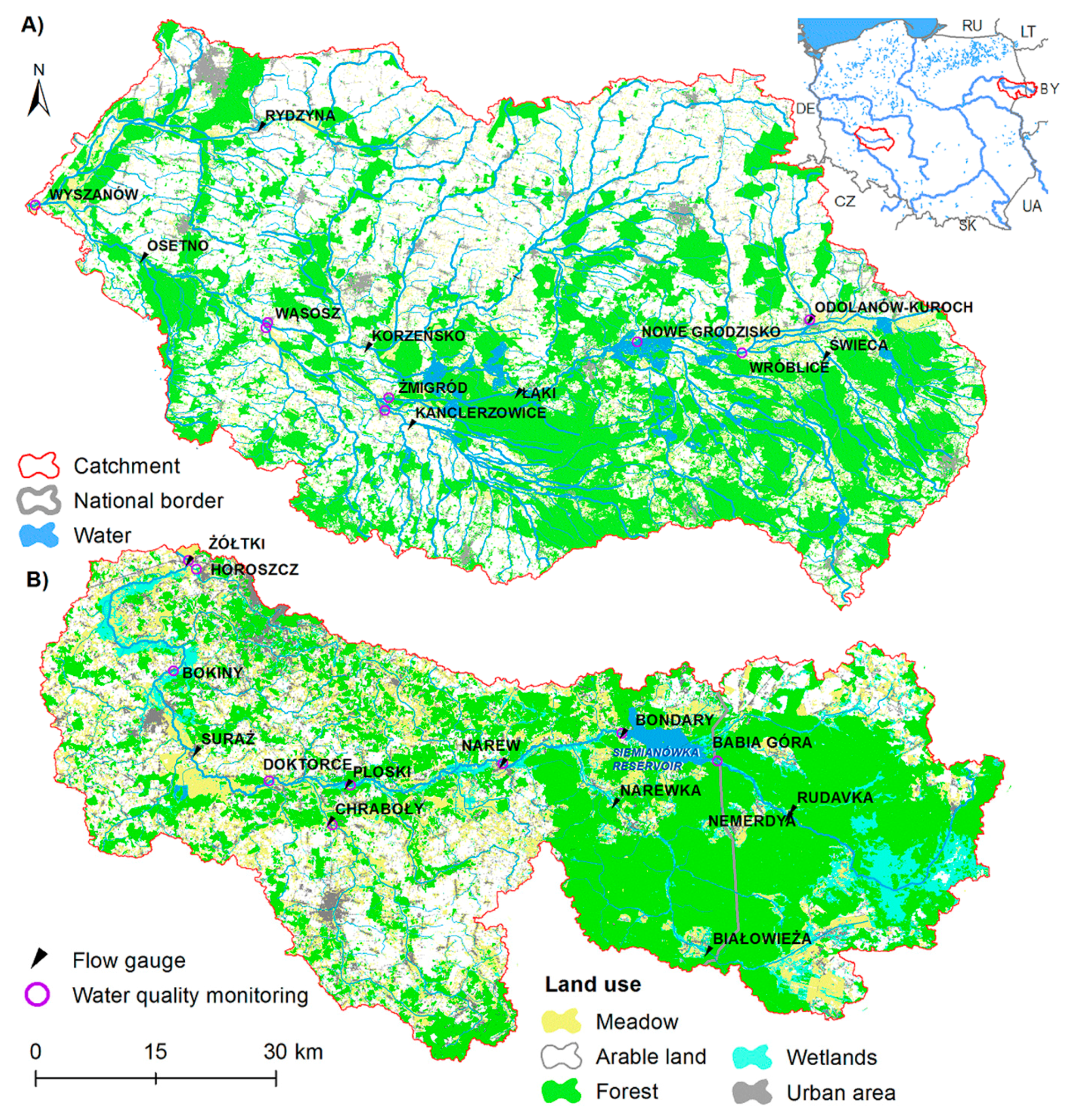

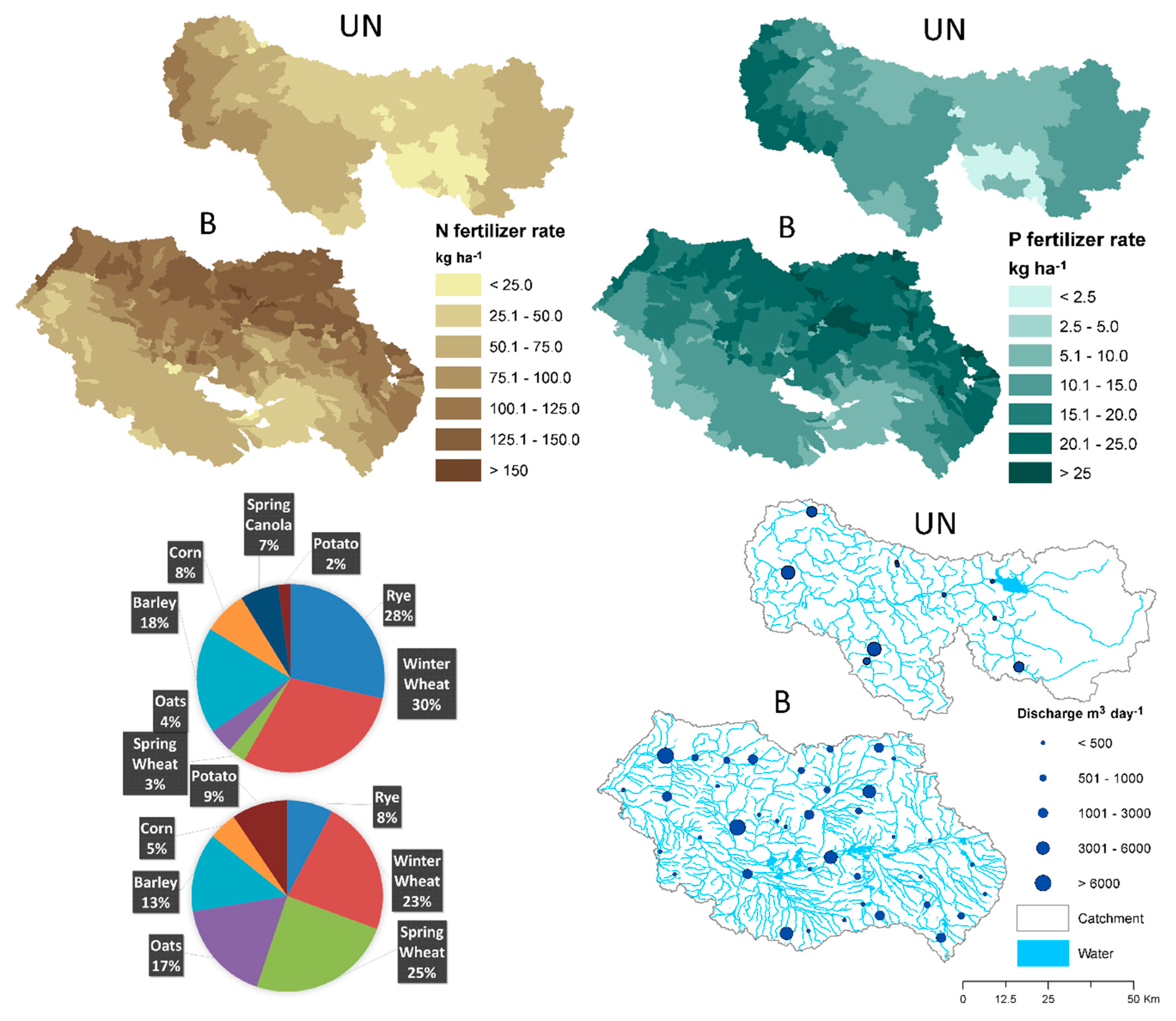
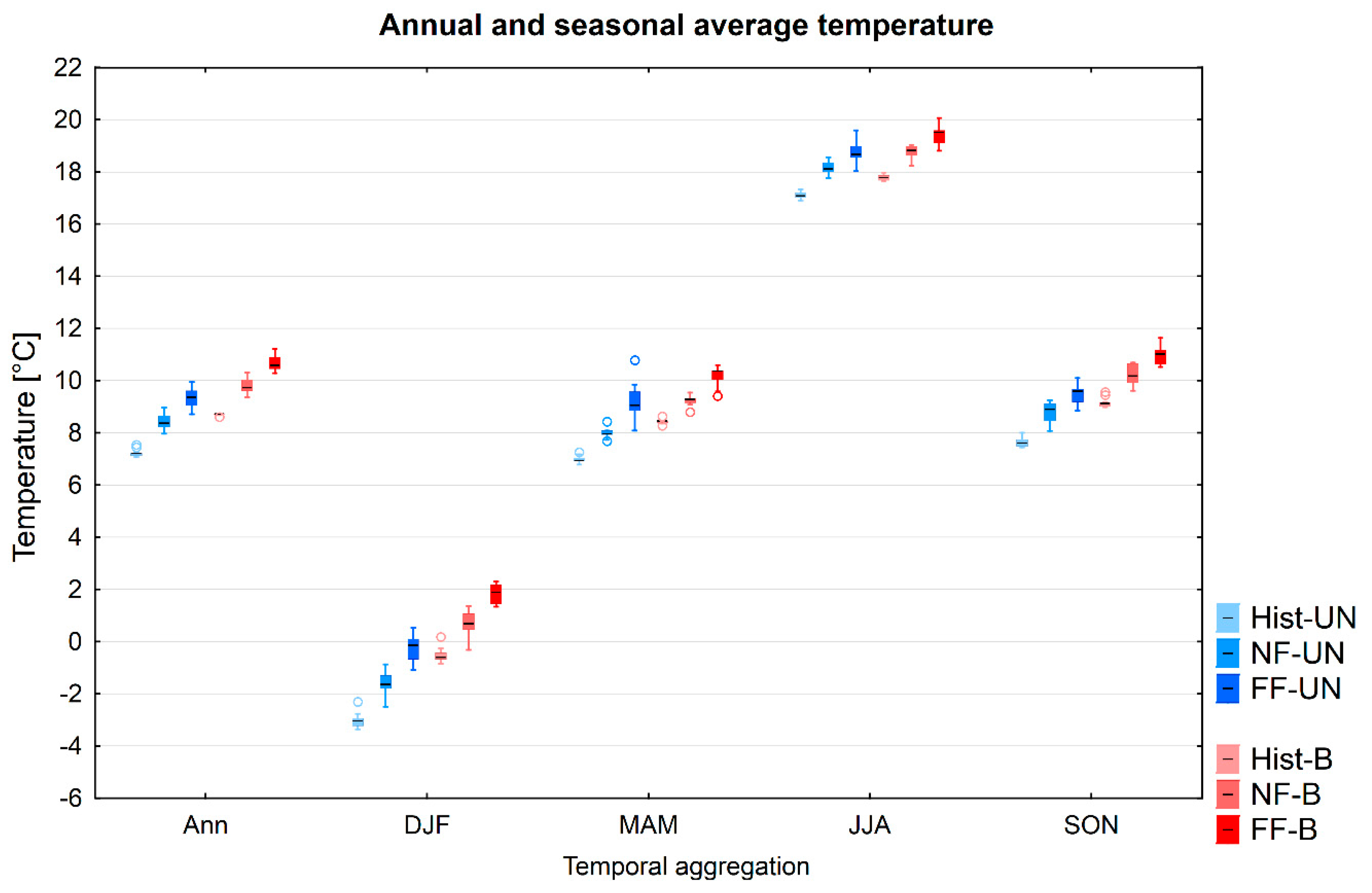
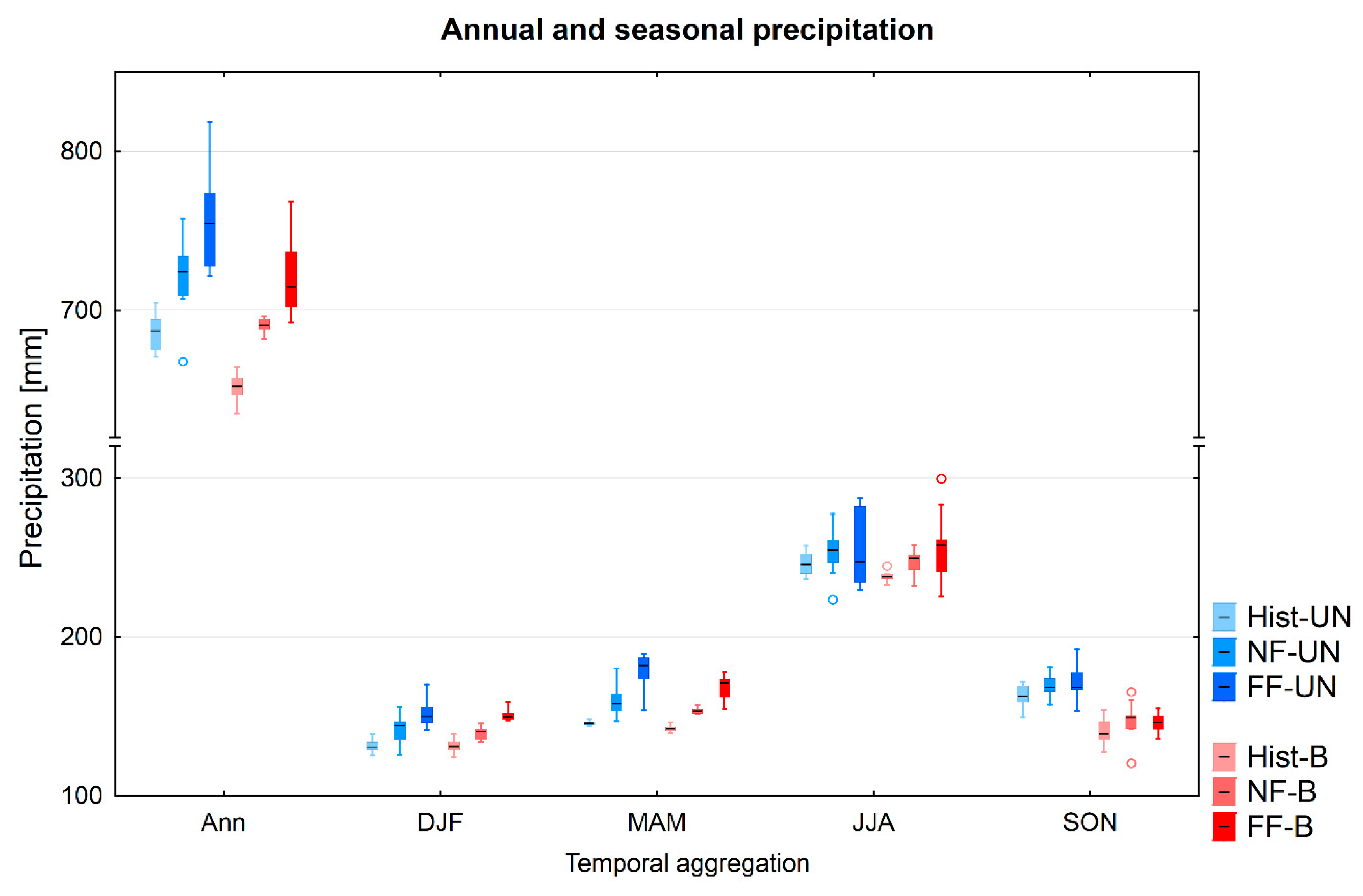
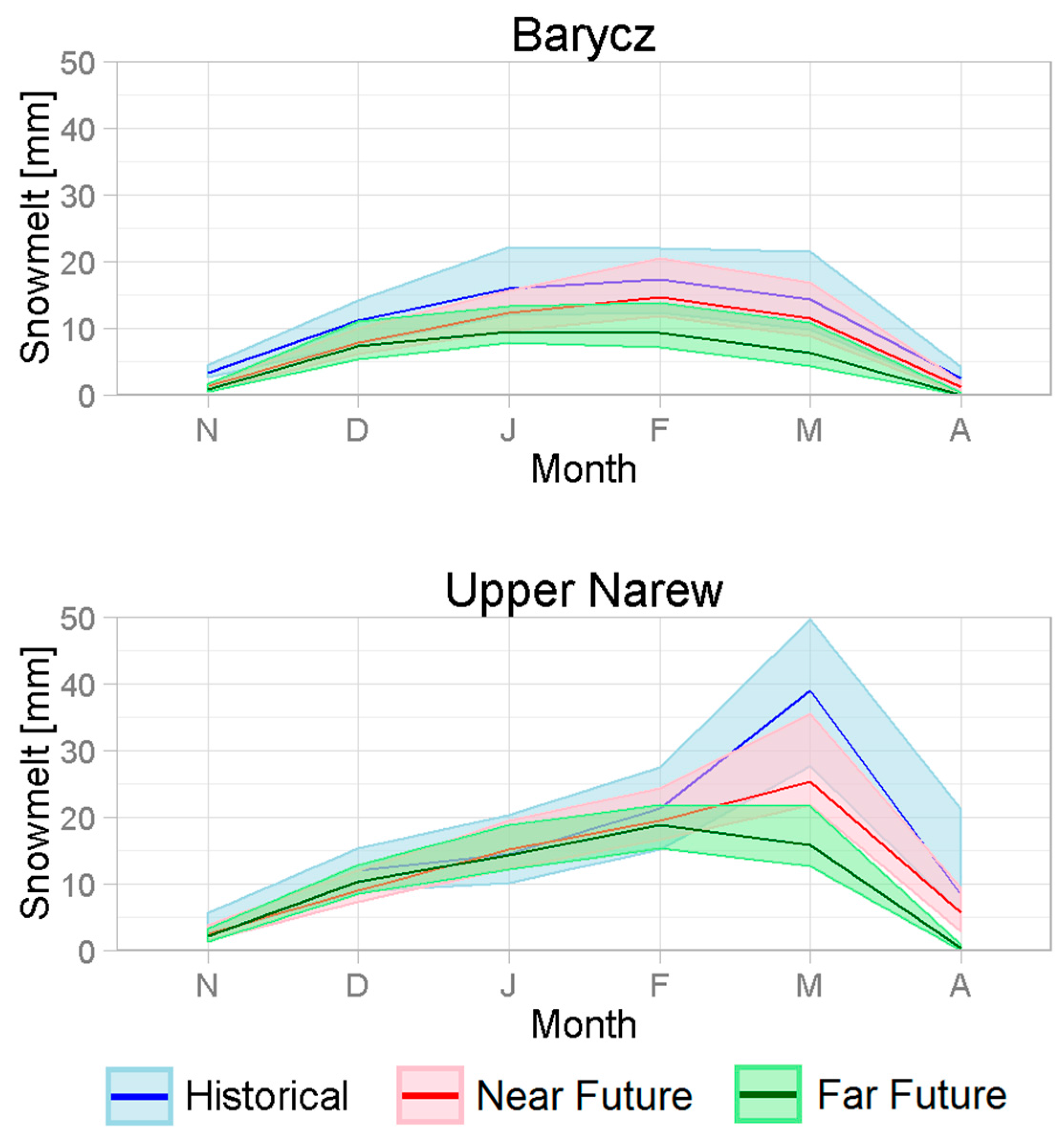
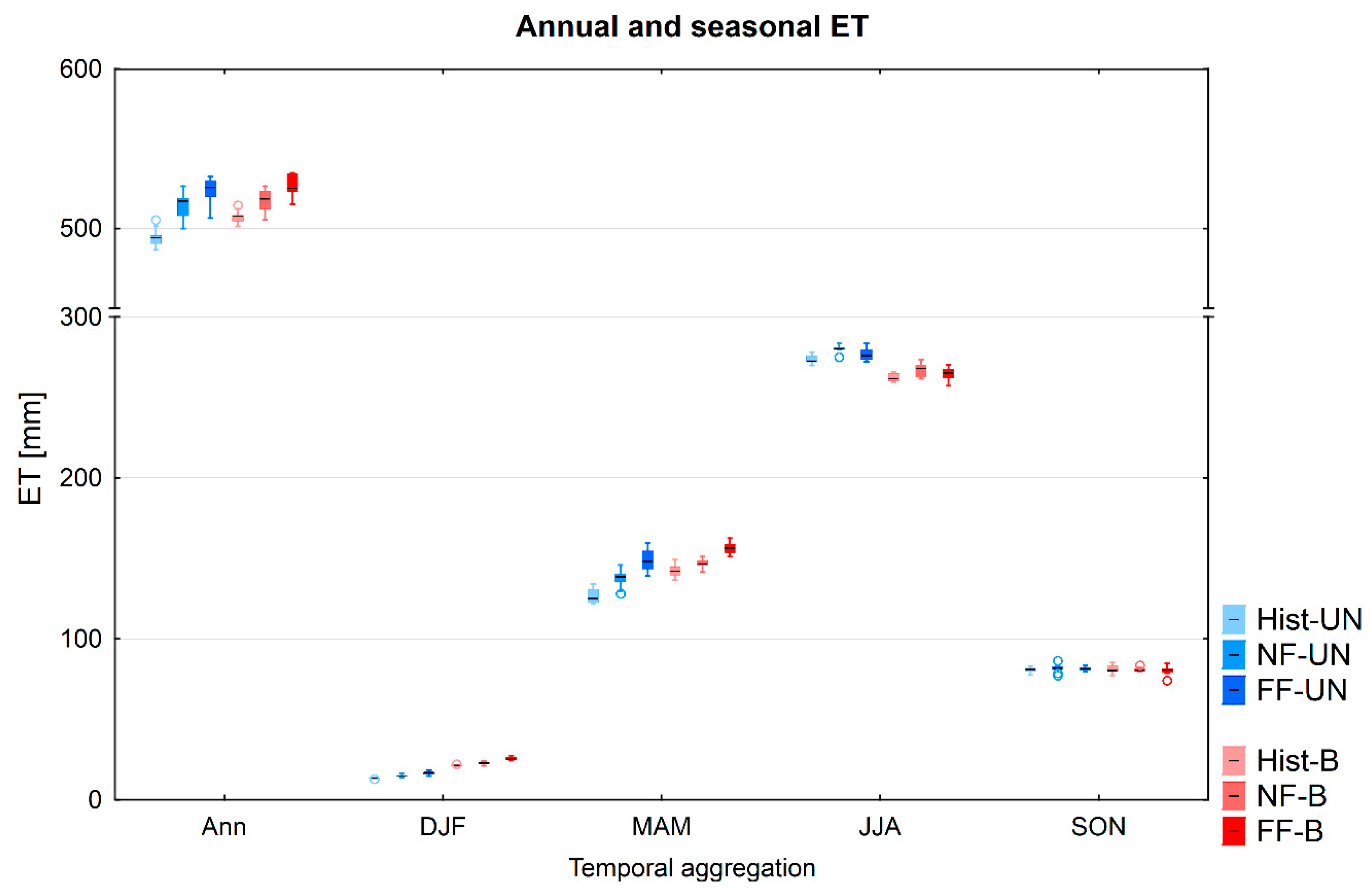


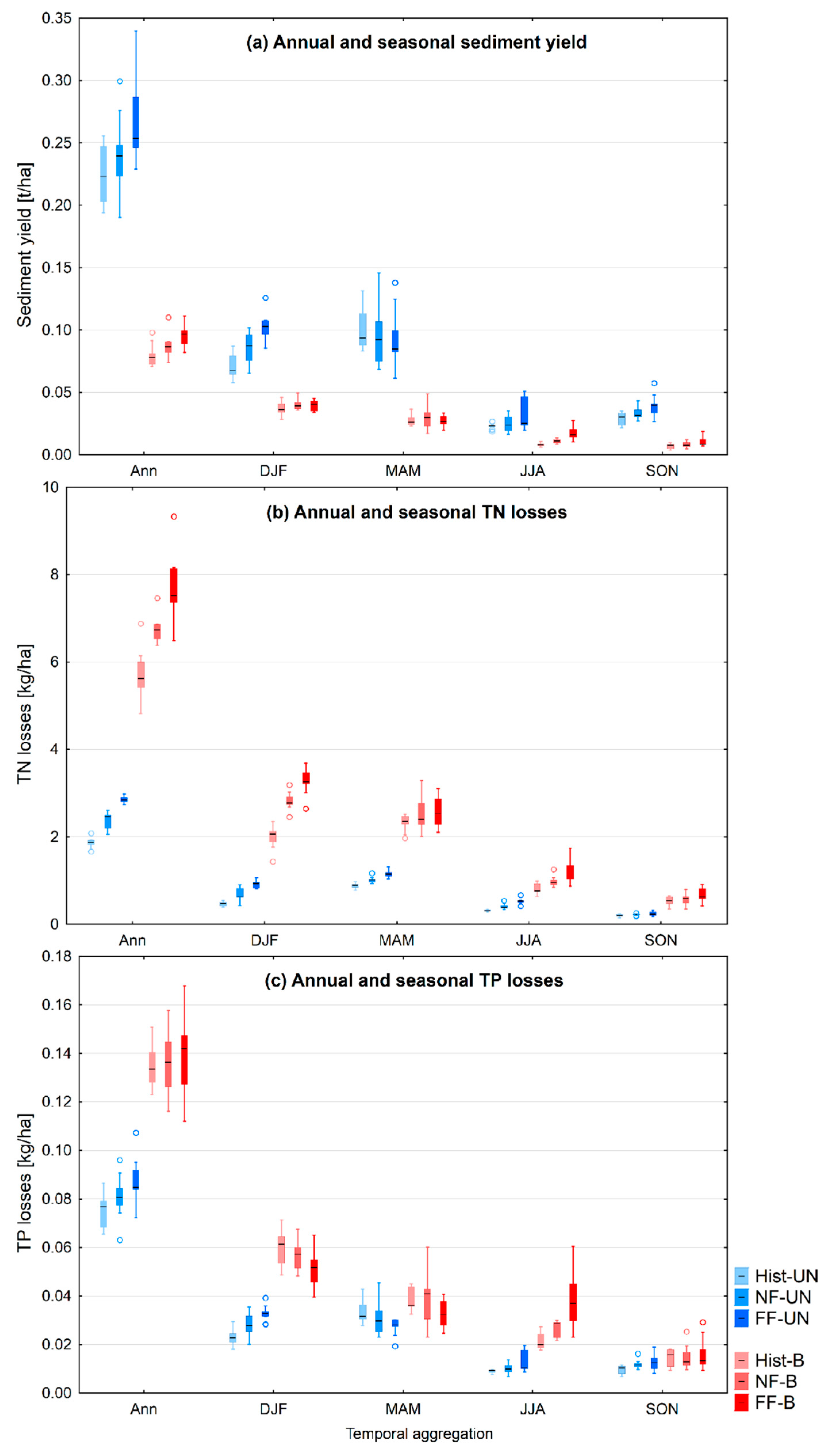
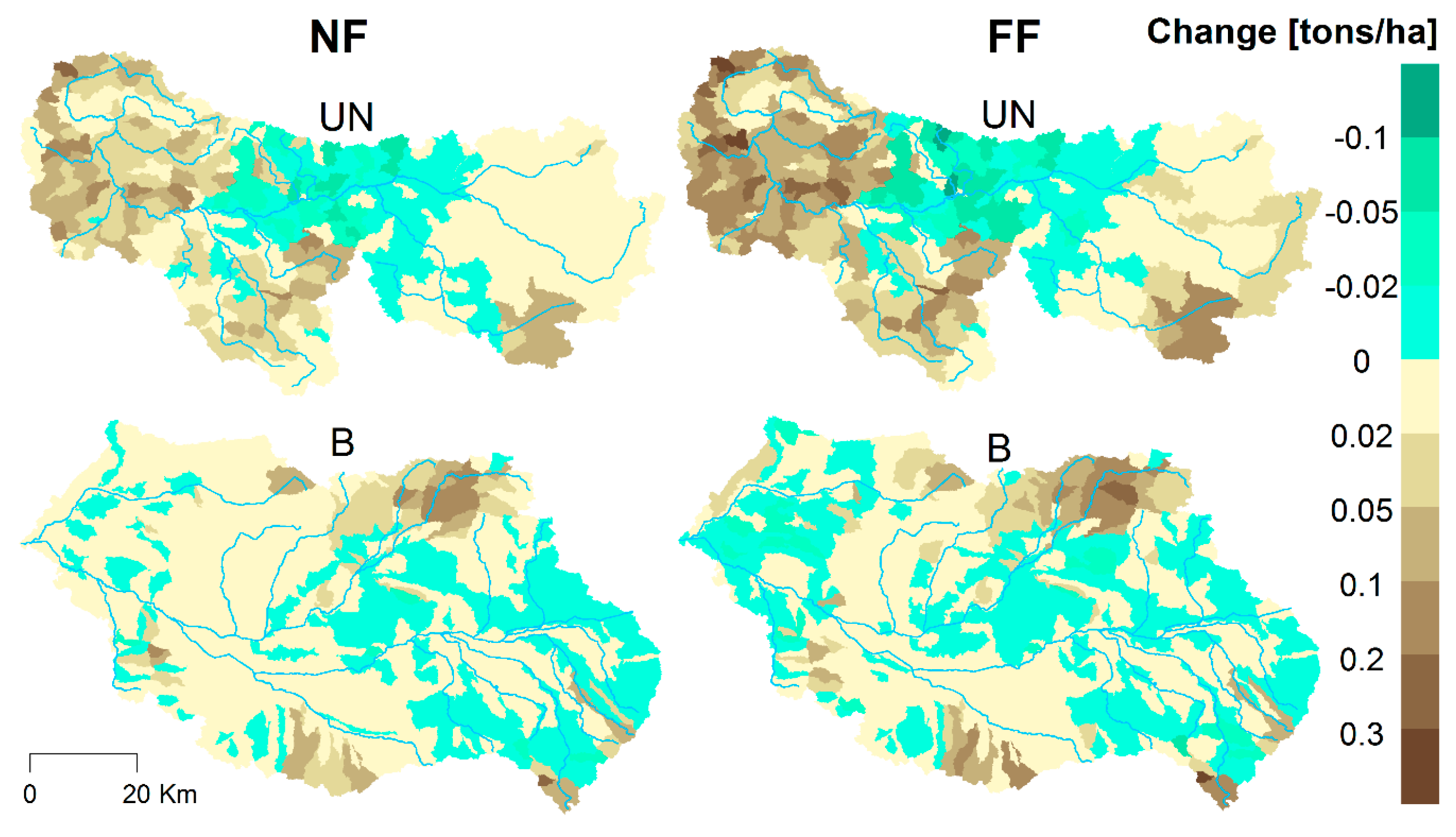
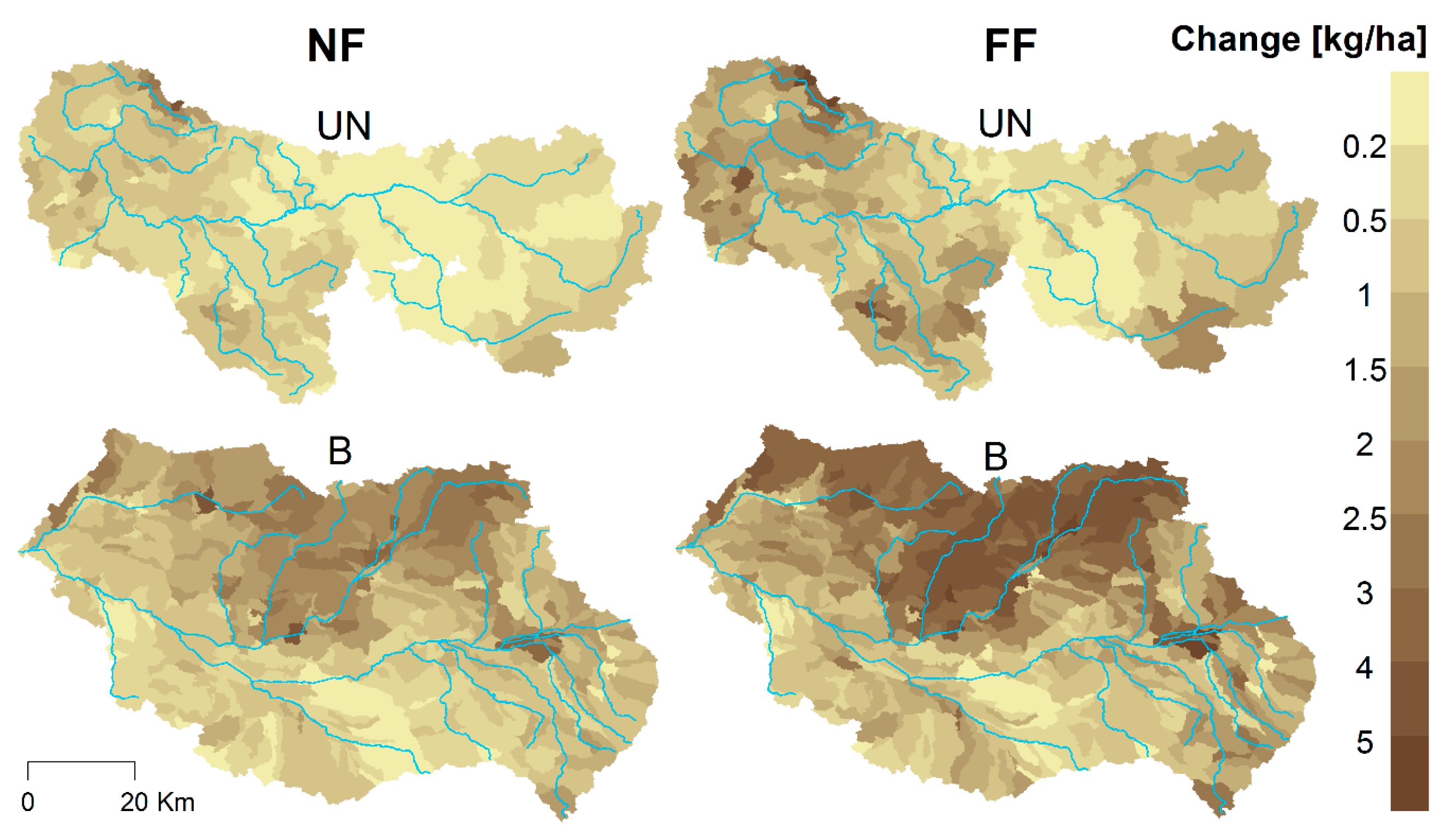
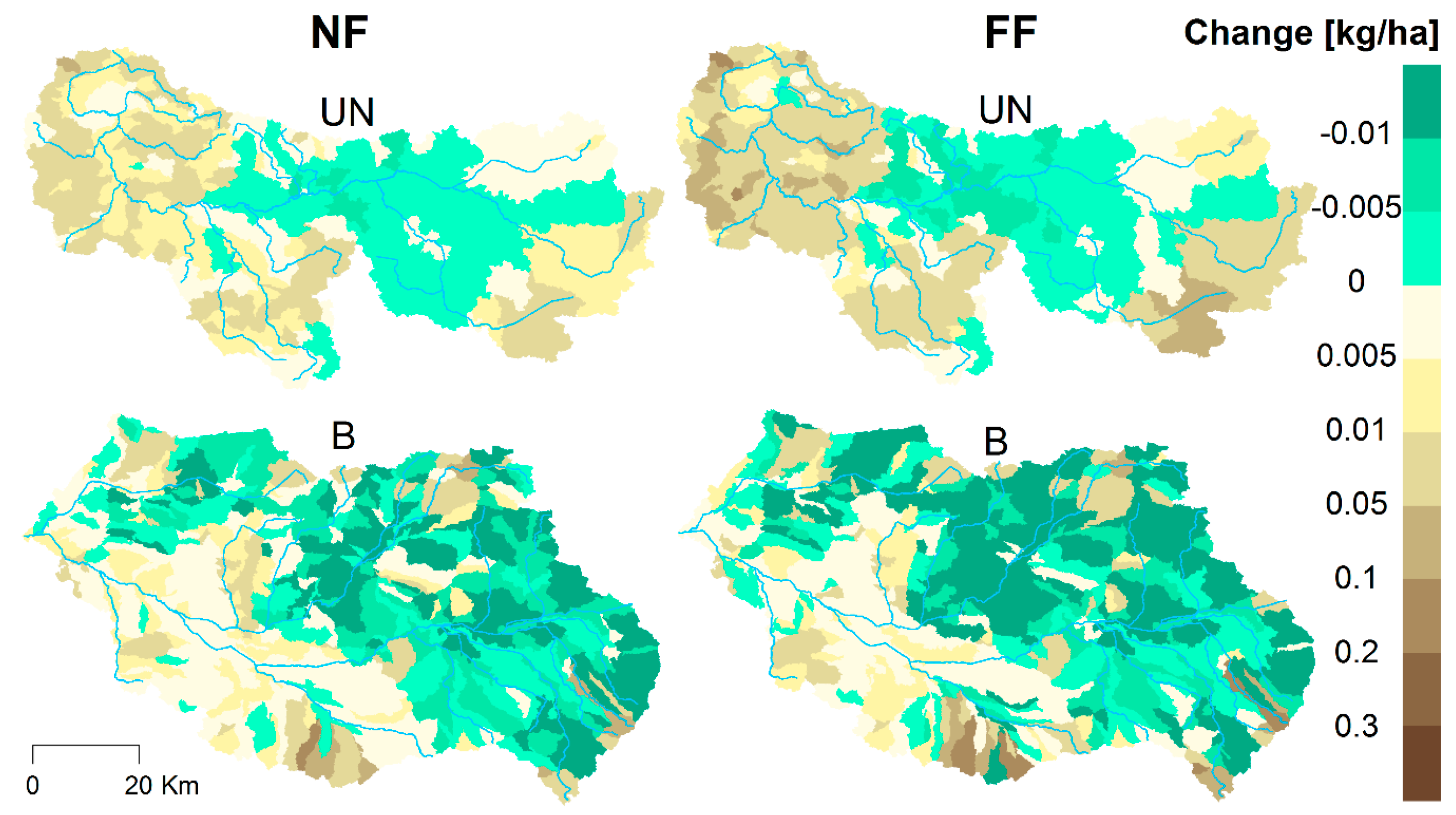
| Reference | Country/Region | Area (km2) | Hydrological Model | Climate Models (Emission Scenarios) | Future Horizons | Effect on: | |||
|---|---|---|---|---|---|---|---|---|---|
| Flow | Sediment Load | TN * Load | TP * Load | ||||||
| [11] | USA | 248 | SWAT | 112(3) | 2015–2034 2045–2064 2080–2099 | --- | --- | ↑ | ↑ |
| [20] | Baltic Sea Basin | 1,700,000 | HYPE | 16(4) | 1971–2000 2071–2100 | ↓↑ | ↓↑ | ↓↑ | |
| [18] | USA | 17,000 | SWAT | 19(4) | 2046–2065 2080–2099 | ↓ | ↓ | ||
| [25] | Canada | 3858 | SWAT | 1(1) | 2025-2050 | ↑ | --- NO3 | ↑PO4 | |
| [13] | Slovenia | 30 | SWAT | 6(1) | 2001–2030 2031–2060 2061–2090 | ↑ | ↑ | ↑ | ↑ |
| [15] | Canada | 630 | SWAT | 6(1) | 2041-2070 | ↑ | ↑ | ↑ | |
| [26] | Poland, Russia | 20,730 | SWIM | 15(1) | 1971–2000 2011–2040 2041–2070 2071–2098 | ↑ | ↓NO3 | ↑PO4 | |
| [12] | Finland | 301,300 | VEMALA | 3(1) | 1971–2000 2010–2039 2040–2069 | ↑ | ↑ | ↑ | |
| [24] | USA | 7588 | SWAT | 3(3) | 2046–2065 2080–2099 | ↑ | ↑ | --- | ↑ |
| [19] | USA | 492,000 | SWAT | 1(1) | 2046–2065 | ↓ | ↓NO3 | ||
| [16] | Mongolia | 447,000 | WaterGAP3 | 1(1) | 2071–2100 | ↑ | ↑ | ||
| [8] | Czech Republic | 2180 | SWIM | 2(1) | 2011–2040 2041–2070 2071–2100 | ↑ | ↑NO3 | ||
| [23] | Canada | 629 | SWAT | 3(1) | 2041–2070 | ↑ | --- | ↑ | ↑ |
| [14] | Germany | 980 | SWAT | 7(2) | 2041–2070 | ↑ | ↑NO3 | ↑ | |
| [9] | Baltic Sea Basin | 1,700,000 | HYPE/STAT | 8(2) | 1961–2099 | ↑ | ↑ | ↑ | |
| [22] | Spain | 88 | SWAT | 11(3) | 2046–2065 2081–2100 | ↓ | ↓NO3 | ↓↑ | |
| [10] | Poland | 482 | SWAT | 1(1) | 2050 | ↑ | ↑NO3 | ↑PO4 | |
| [21] | USA | 4000 | SWAT | 6(2) | 2030–2059 | ↓↑ | ↓↑ | ↓↑ | ↓↑ |
| [17] | USA | 505 | SWAT | 1(1) | 2011–2040 2041–2070 2071–2100 | ↓ | ↓NO3 | ||
| Category | Parameter | Barycz | Upper Narew * |
|---|---|---|---|
| Agriculture | Fraction of arable land (%) | 47 | 23 |
| Fraction of grassland (%) | 9 | 18 | |
| Mineral nitrogen fertilizer rate (kg·ha−1) | 91 | 45 | |
| Mineral phosphorus fertilizer rate (kg·ha−1) | 17 | 10 | |
| Livestock density (LSU·ha−1) | 1.21 | 0.73 | |
| Urban | Population density (persons·km−2) | 89 | 36 |
| Fraction of high density urban land cover (%) | 1.2 | 0.45 | |
| Number of point sources (per 1000 km2) | 7.1 | 3.5 | |
| Specific wastewater discharge from WWTPs (dm3·s−1·km−2) | 0.09 | 0.03 | |
| Specific sediment load from WWTPs (Mg year−1·km−2) | 0.3 | 0.03 | |
| Specific TN load from WWTPs (kg·year−1·km−2) | 47.5 | 36.9 | |
| Specific TP load from WWTPs (kg·year−1·km−2) | 8.2 | 2.8 | |
| Water Retention | Fish ponds volume (103 m3/km2) | 12.9 | 1.3 |
| Reservoir volume (103 m3/km2) | - | 20 |
| Data Type | Source | Resolution/Scale |
|---|---|---|
| DEM PL | CODGiK | 10 m |
| DEM BY | SRTM v4.1 (NASA) | Horizontal 90 m; Vertical 16 m |
| Rivers and lakes PL | MPHP2010 (IMGW-PIB) | 1:10,000 |
| Land Cover PL | Landsat 8 CLC 2006 (GDOS) | 30 m 100 m |
| Land Cover BY | MODIS Landcover | 500 m |
| Soil map PL | IUNG-PIB | 1:100,000 |
| Soil map BY | HWSD v 1.2 | 1:1,000,000 |
| Climate PL/BY | CPLFD-GDPT5 | 5 km |
| Atmospheric deposition of nitrogen (dry and wet) | GIOS | 1 station for the Upper Narew/3 stations for the Barycz (outside the catchment) |
| Agricultural statistics | GUS | Commune level |
© 2017 by the authors. Licensee MDPI, Basel, Switzerland. This article is an open access article distributed under the terms and conditions of the Creative Commons Attribution (CC BY) license ( http://creativecommons.org/licenses/by/4.0/).
Share and Cite
Marcinkowski, P.; Piniewski, M.; Kardel, I.; Szcześniak, M.; Benestad, R.; Srinivasan, R.; Ignar, S.; Okruszko, T. Effect of Climate Change on Hydrology, Sediment and Nutrient Losses in Two Lowland Catchments in Poland. Water 2017, 9, 156. https://doi.org/10.3390/w9030156
Marcinkowski P, Piniewski M, Kardel I, Szcześniak M, Benestad R, Srinivasan R, Ignar S, Okruszko T. Effect of Climate Change on Hydrology, Sediment and Nutrient Losses in Two Lowland Catchments in Poland. Water. 2017; 9(3):156. https://doi.org/10.3390/w9030156
Chicago/Turabian StyleMarcinkowski, Paweł, Mikołaj Piniewski, Ignacy Kardel, Mateusz Szcześniak, Rasmus Benestad, Raghavan Srinivasan, Stefan Ignar, and Tomasz Okruszko. 2017. "Effect of Climate Change on Hydrology, Sediment and Nutrient Losses in Two Lowland Catchments in Poland" Water 9, no. 3: 156. https://doi.org/10.3390/w9030156








